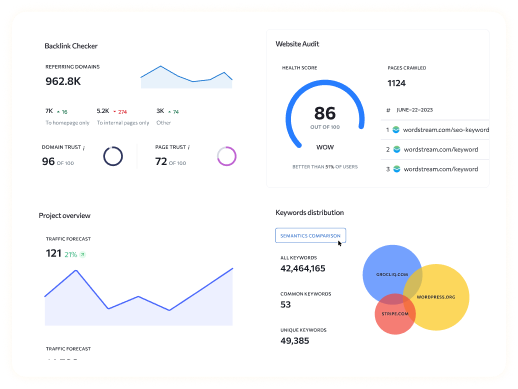If you’ve ever asked, Is Squarespace easy to optimize for SEO?, you’re in the right place. Squarespace is a popular website builder that’s well-known for its stunning templates and ease of use, but when it comes to SEO, the experience can be a little different compared to other platforms. While Squarespace offers a solid foundation for SEO, there are both pros and cons to consider when deciding whether it’s the right choice for your website’s search engine optimization needs.
In this comprehensive guide, we’ll take a deep dive into Squarespace’s SEO capabilities, what makes it easy or difficult to optimize, and actionable steps to help you improve your site’s SEO performance. By the end of this article, you’ll know whether Squarespace is easy to optimize for SEO and how to get the best results possible.
Understanding Squarespace and SEO
What is Squarespace?
Squarespace is a user-friendly website builder that allows people to create stylish and functional websites without any technical know-how. It’s particularly popular among small business owners, bloggers, creatives, and anyone looking for a sleek, easy-to-manage platform. Squarespace allows you to build a professional website using customizable templates, but when it comes to SEO, it has some unique strengths and weaknesses.
So, the question remains: Is Squarespace easy to optimize for SEO? In short, it’s not as flexible or advanced as platforms like WordPress, but it still provides enough features for beginners and small business owners to succeed with SEO.
SEO Basics – What Does It Take to Rank on Google?
Before diving into how Squarespace handles SEO, it’s important to understand the basics of SEO itself. To rank well on Google, you need to focus on three main areas:
- On-Page SEO: This includes optimizing things like titles, meta descriptions, URLs, and images. It’s all about making sure your pages are easily understandable for both search engines and users.
- Technical SEO: Ensuring your site loads fast, is mobile-friendly, and has a clean structure for search engine crawlers.
- Content: High-quality, relevant content is crucial for SEO. It helps to answer search queries and build backlinks to your site.
Now that we’ve got the basics down, let’s take a closer look at how Squarespace is easy to optimize for SEO.
Is Squarespace Easy to Optimize for SEO? The Pros
User-Friendly SEO Settings
One of the best features of Squarespace is its user-friendly SEO settings. You don’t have to be a tech expert to optimize your site’s SEO. Squarespace provides an easy-to-use interface for adding SEO titles, descriptions, and URLs. It also integrates with Google Search Console, so you can track your site’s performance and fix any SEO issues that might arise.
For those asking, Is Squarespace easy to optimize for SEO in terms of on-page SEO? The answer is yes. You’ll find it straightforward to adjust these settings and make your site SEO-friendly right from the start.
Mobile-Friendly and Responsive Design
Google places a strong emphasis on mobile-friendliness when determining search rankings, so a mobile-optimized website is a must. Squarespace templates are all responsive, meaning your site will automatically adjust to look great on any device, from desktop to mobile. This is huge for SEO since it ensures that your site is compliant with Google’s mobile-first indexing.
So, if you’re asking, Is Squarespace easy to optimize for SEO in terms of mobile-friendliness, the answer is a resounding yes. Squarespace handles this automatically, giving your site a solid SEO foundation from the start.
Clean HTML Code
Squarespace also generates clean, bloat-free HTML code, which is a major advantage for SEO. A clean code structure makes it easier for search engines to crawl and index your site, potentially boosting your SEO rankings. It’s one of the reasons why many users find Squarespace a solid option for creating SEO-friendly websites without a ton of manual work.
Automatic XML Sitemap Generation
An XML sitemap is essential for SEO because it tells search engines where all your important pages are located on your site. Squarespace automatically generates an XML sitemap for you, which helps search engines crawl and index your content more efficiently. This is one less thing to worry about when optimizing your Squarespace site.
The Challenges of Optimizing Squarespace for SEO
While Squarespace is certainly easy to use and offers a lot of built-in SEO tools, it does have its limitations. If you’re wondering, Is Squarespace easy to optimize for SEO in a more advanced sense, the answer is a bit more complicated. Here are some of the challenges you may face:
Limited Control Over Advanced SEO Features
One of the main downsides of using Squarespace for SEO is the limited control you have over advanced SEO features. Unlike WordPress, which allows you to add custom plugins like Yoast or RankMath, Squarespace doesn’t offer as much customization. For example, it can be difficult to edit your robots.txt file, set up canonical tags, or implement schema markup.
If you need these advanced features to fine-tune your SEO, Squarespace might feel restrictive. So, is Squarespace easy to optimize for SEO in this regard? It’s easier for beginners but may be limiting for more advanced users.
Page Speed Limitations
Page speed is another area where Squarespace can fall short. While the platform is generally easy to use, the sites you build can sometimes suffer from slower load times, especially if you’re using lots of high-quality images or animations. Slow page speeds are a red flag for Google’s Core Web Vitals, which can negatively impact your rankings.
If you’re asking, Is Squarespace easy to optimize for SEO when it comes to page speed? The answer is that it requires some effort on your part to keep things fast.
Heading Structure Problems
In terms of SEO best practices, having a proper heading structure is crucial. Squarespace’s default settings sometimes make it difficult to ensure that headings are properly nested. For example, the H1 tag is often used incorrectly or doesn’t stand out enough, which can affect your content hierarchy and SEO.
Image Optimization Issues
Images are an important part of any website, but Squarespace doesn’t automatically compress them or support next-gen formats like WebP. As a result, your images may be larger than they need to be, slowing down your site and harming your SEO.
Actionable Tips to Optimize SEO on Squarespace
If you’re wondering how to make the most of Squarespace’s SEO capabilities, here are some tips to improve your website’s performance:
Optimize On-Page Elements
- Title & Meta Descriptions: Add unique SEO titles and meta descriptions for each page to make your content more appealing to search engines.
- URLs: Use short, descriptive, and keyword-rich URLs for each page.
Improve Heading Structure
Ensure your headings are properly nested. Use H1 for the main title and H2 or H3 for subheadings to create a clear content hierarchy.
Boost Page Speed
- Compress your images before uploading them.
- Minimize unnecessary scripts and animations that can slow down your page load times.
Add Structured Data (Schema Markup)
If you want to enhance your SEO further, consider adding schema markup to your pages. You can use custom code injection to add this data, which helps search engines better understand your content.
Create High-Quality Content and Build Backlinks
Consistently publish keyword-optimized blog posts and build backlinks through outreach to other sites.
Squarespace vs. Other Website Platforms for SEO
Squarespace vs. WordPress
WordPress is the king of SEO due to its flexibility and the vast number of plugins available for advanced customization. Squarespace is easier to use but offers less flexibility in terms of advanced SEO features.
Squarespace vs. Wix and Showit
Wix and Showit offer similar ease of use, but Squarespace’s designs are generally better suited for SEO, especially with its automatic mobile optimization.
When to Choose Squarespace for SEO
Squarespace is a great choice if you’re looking for simplicity and ease of use. It’s ideal for non-technical users, small businesses, and creatives who need a solid SEO foundation without a lot of hassle.
Conclusion
So, is Squarespace easy to optimize for SEO? The answer is yes – for beginners, Squarespace offers a solid SEO foundation with user-friendly features. However, it’s not as flexible as other platforms like WordPress, and advanced SEO techniques may require some workarounds. With the right strategies in place, though, Squarespace can perform well and help your website rank on Google.
Note: Read Our Latest Blogs:
Blog Post with AI | What is SEO Intelligence? | AI SEO for WordPress | AI SEO Tips | AI SEO for Wix | BigCommerce Status and Ensuring Seamless Operations | SEO Practices for Wix | Is Wix SEO Friendly? | Wix SEO Apps | Wix Header Code Meta Tags for Better SEO
Frequently Asked Questions
Q1. Is Squarespace easy to optimize for SEO?
Ans: Yes, Squarespace is easy to optimize for SEO for beginners, though advanced SEO features may require more effort.
Q2. Can I use plugins to improve SEO on Squarespace?
Ans: Unlike WordPress, Squarespace doesn’t support third-party plugins, but it offers built-in SEO tools to help with optimization.
Q3. Does Squarespace automatically create a sitemap?
Ans: Yes, Squarespace automatically generates an XML sitemap, which is essential for SEO.
Q4. Is Squarespace mobile-friendly for SEO?
Ans: Yes, all Squarespace templates are responsive, ensuring your site is optimized for mobile-first indexing.
Q5. Can I edit meta tags and titles on Squarespace?
Ans: Yes, Squarespace allows you to customize SEO titles, meta descriptions, and URLs for each page.
Q6. How can I speed up my Squarespace site for better SEO?
Ans: You can compress images, minimize animations, and remove unnecessary scripts to improve page speed.
Q7. Can I add custom code to improve SEO on Squarespace?
Ans: Yes, Squarespace allows you to inject custom code, including structured data (schema markup), to improve your site’s SEO.
Q8. Does Squarespace support schema markup for SEO?
Ans: While Squarespace doesn’t offer a built-in tool for schema markup, you can use custom code to add it to your pages.





